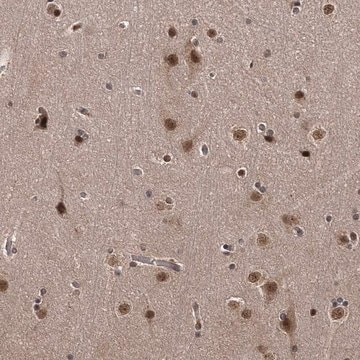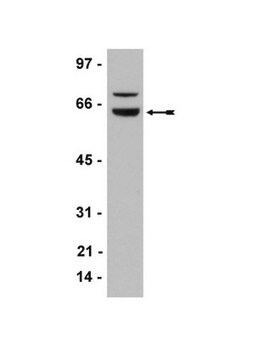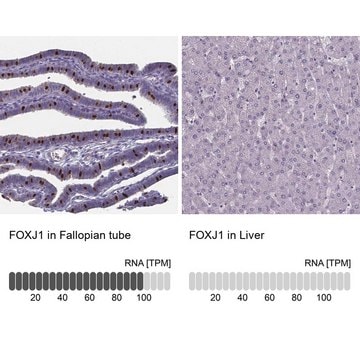추천 제품
관련 카테고리
일반 설명
Wilms tumor 1 (WT1) is a transcription factor with C-terminal zinc-finger motifs and an N-terminal proline/glutamine-rich DNA-binding domain. WT1 gene is mapped to human chromosome 11p13. WT1 expression occurs in the spleen, kidneys, gonads, and abdominal cavity lining during vertebrate development. WT1 exists as multiple transcript variants, resulting from alternative splicing at two coding exons. Evidence suggests the use of non-AUG (CUG) translation initiation site upstream of, and in-frame with the first AUG, leading to additional isoforms.
면역원
Synthetic peptide directed towards the N terminal region of human WT1
애플리케이션
Anti-WT1 antibody produced in rabbit has been used in western blotting.
생화학적/생리학적 작용
Wilms tumor 1 (WT1) participates in the homeostasis of the adrenal glands and gonads. WT1 functions as an oncogene and its expression are observed in a majority of tumors associated with neuronal, hematopoietic, epithelial, and mesenchymal tissues. It serves as a target for cancer immune therapy. WT1 displays a tumor suppressor role in acute myeloid leukemia (AML). Mutations in the WT1 gene is also implicated in the pathophysiology of Denys-Drash syndrome (DDS) and Frasier syndrome (FS).
서열
Synthetic peptide located within the following region: PASQHTLRSGPGCLQQPEQQGVRDPGGIWAKLGAAEASAERLQGRRSRGA
물리적 형태
Purified antibody supplied in 1x PBS buffer with 0.09% (w/v) sodium azide and 2% sucrose.
면책조항
Unless otherwise stated in our catalog or other company documentation accompanying the product(s), our products are intended for research use only and are not to be used for any other purpose, which includes but is not limited to, unauthorized commercial uses, in vitro diagnostic uses, ex vivo or in vivo therapeutic uses or any type of consumption or application to humans or animals.
Not finding the right product?
Try our 제품 선택기 도구.
Storage Class Code
10 - Combustible liquids
WGK
WGK 3
Flash Point (°F)
Not applicable
Flash Point (°C)
Not applicable
시험 성적서(COA)
제품의 로트/배치 번호를 입력하여 시험 성적서(COA)을 검색하십시오. 로트 및 배치 번호는 제품 라벨에 있는 ‘로트’ 또는 ‘배치’라는 용어 뒤에서 찾을 수 있습니다.
Min Hu et al.
Pediatric nephrology (Berlin, Germany), 19(10), 1160-1163 (2004-09-07)
We report a novel mutation in WT1 exon 9 (1214 A>G) resulting in an amino acid change from H to R at codon 405 in a 46 XY female patient who had congenital hypertrophic pyloric stenosis, pseudohermaphroditism masculinus, renal failure
L Yang et al.
Leukemia, 21(5), 868-876 (2007-03-16)
The Wilms' tumor 1 (WT1) gene encodes a transcription factor important for normal cellular development and cell survival. The initial discovery of WT1 as the causative gene in an autosomal-recessive condition identified it as a tumor suppressor gene whose mutations
Nicholas D Hastie
Development (Cambridge, England), 144(16), 2862-2872 (2017-08-16)
The study of genes mutated in human disease often leads to new insights into biology as well as disease mechanisms. One such gene is Wilms' tumour 1 (WT1), which plays multiple roles in development, tissue homeostasis and disease. In this
W Bruening et al.
The Journal of biological chemistry, 271(15), 8646-8654 (1996-04-12)
The Wilms' tumor (WT) suppressor gene, WT1, is mutated in a small set of WTs and is essential for proper development of the urogenital system. The gene has three sites of transcriptional initiation and produces mRNA transcripts containing 5'-untranslated regions
Aneta A Koronowicz et al.
PPAR research, 2017, 2865283-2865283 (2017-05-02)
In our previous study, we showed that fatty acids from CLA-enriched egg yolks (EFA-CLA) reduced the proliferation of breast cancer cells; however, the molecular mechanisms of their action remain unknown. In the current study, we used MCF-7 breast cancer cell
자사의 과학자팀은 생명 과학, 재료 과학, 화학 합성, 크로마토그래피, 분석 및 기타 많은 영역을 포함한 모든 과학 분야에 경험이 있습니다..
고객지원팀으로 연락바랍니다.








